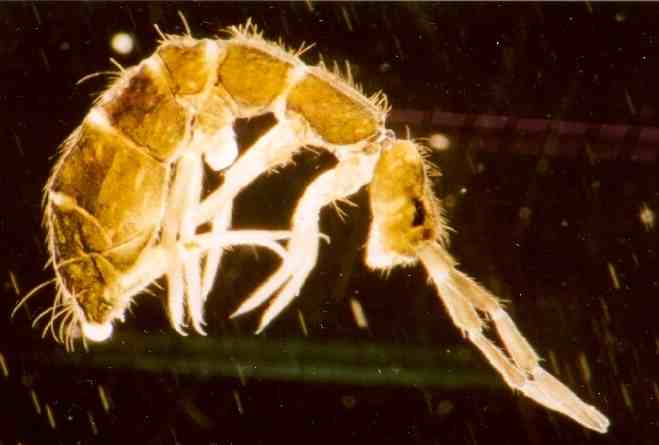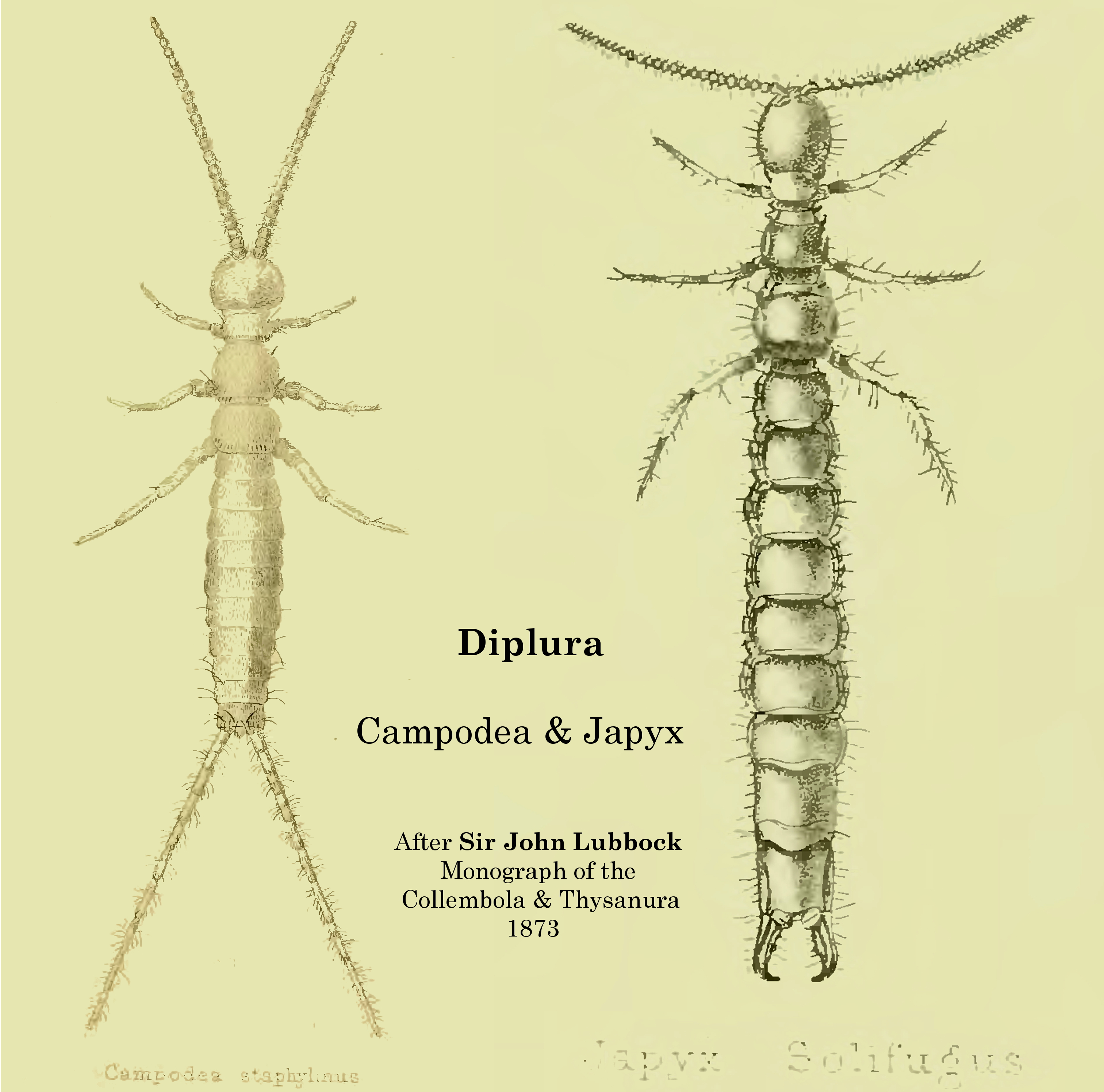|
Entognatha
The Entognatha, from Ancient Greek ἐντός (''entós''), meaning "inside", and γνάθος (''gnáthos''), meaning "jaw", are a class (biology), class of wingless and Ametabolism, ametabolous arthropods, which, together with the insects, makes up the subphylum Hexapoda. Their Arthropod mouthparts, mouthparts are entognathous, meaning that they are retracted within the head, unlike the insects. Entognatha are apterous, meaning that they lack insect wing, wings. The class contains three Order (biology), orders: Collembola (springtails, 9000 species), Diplura ("two-tail", 1000 species) and Protura ("first-tail", 800 species). These three groups were historically united with the now-obsolete order Thysanura to form the class Apterygota, but it has since been recognized that the hexapodous condition of these animals has evolved independently from that of insects, and independently ''within'' each order. The orders might not be closely related, and Entognatha is now considered to ... [...More Info...] [...Related Items...] OR: [Wikipedia] [Google] [Baidu] |
Hexapoda
The subphylum Hexapoda (from Greek for 'six legs') or hexapods comprises the largest clade of arthropods and includes most of the extant arthropod species. It includes the crown group class Insecta (true insects), as well as the much smaller clade Entognatha, which includes three classes of wingless arthropods that were once considered insects: Collembola (springtails), Protura (coneheads) and Diplura (two-pronged bristletails). The insects and springtails are very abundant and are some of the most important pollinators, basal consumers, scavengers/ detritivores and micropredators in terrestrial environments. Hexapods are named for their most distinctive feature: a three-part body plan with a consolidated thorax and three pairs of legs. Most other arthropods have more than three pairs of legs. Most recent studies have recovered Hexapoda as a subgroup of Pancrustacea. Morphology Hexapods have bodies ranging in length from 0.5 mm to over 300 mm which are divided ... [...More Info...] [...Related Items...] OR: [Wikipedia] [Google] [Baidu] |
Collembola
Springtails (class Collembola) form the largest of the three lineages of modern hexapods that are no longer considered insects. Although the three lineages are sometimes grouped together in a class called Entognatha because they have internal mouthparts, they do not appear to be any more closely related to one another than they are to insects, which have external mouthparts. Springtails are omnivorous, free-living organisms that prefer moist conditions. They do not directly engage in the decomposition of organic matter, but contribute to it indirectly through the fragmentation of organic matter and the control of soil microbial communities. The word ''Collembola'' is from Ancient Greek 'glue' and 'peg'; this name was given due to the existence of the collophore, which was previously thought to stick to surfaces to stabilize the creature. Early DNA sequence studies suggested that Collembola represent a separate evolutionary line from the other Hexapoda, but others disagree ... [...More Info...] [...Related Items...] OR: [Wikipedia] [Google] [Baidu] |
Springtail
Springtails (class Collembola) form the largest of the three lineages of modern Hexapoda, hexapods that are no longer considered insects. Although the three lineages are sometimes grouped together in a class called Entognatha because they have internal Arthropod mouthparts, mouthparts, they do not appear to be any more closely related to one another than they are to insects, which have external mouthparts. Springtails are omnivorous, free-living organisms that prefer moist conditions. They do not directly engage in the decomposition of organic matter, but contribute to it indirectly through the fragmentation of organic matter and the control of soil microbial communities. The word ''Collembola'' is from Ancient Greek 'glue' and 'peg'; this name was given due to the existence of the collophore, which was previously thought to stick to surfaces to stabilize the creature. Early DNA sequence studies suggested that Collembola represent a separate Lineage (evolution), evolutionary ... [...More Info...] [...Related Items...] OR: [Wikipedia] [Google] [Baidu] |
Diplura
The order Diplura ("two-pronged bristletails") is one of three orders of non-insect hexapods within the class Entognatha (alongside Collembola (springtails) and Protura). The name "diplura", or "two tails", refers to the characteristic pair of caudal appendages or filaments at the terminal end of the body. Around 800 species of diplurans have been described. Anatomy Diplurans are typically long, with most falling between . However, some species of '' Japyx'' may reach . They have no eyes and, apart from the darkened cerci in some species, they are unpigmented. Diplurans have long antennae with 10 or more bead-like segments projecting forward from the head. The abdomens of diplurans bear eversible vesicles, which seem to absorb moisture from the environment and help with the animal's water balance. The body segments themselves may display several types of setae, or scales and setae. Diplurans possess a characteristic pair of cerci projecting backwards from the last of ... [...More Info...] [...Related Items...] OR: [Wikipedia] [Google] [Baidu] |
Apterygota
The name Apterygota is sometimes applied to a former Subclass (biology), subclass of small, agile insects, distinguished from other insects by their lack of wings in the present and in their evolutionary history; notable examples are the silverfish, the firebrat, and the Archaeognatha, jumping bristletails. Their first known occurrence in the fossil record is during the Devonian period, 417–354 million years ago. The group Apterygota is not a clade; it is paraphyletic, and not recognized in modern classification schemes. As defined, the group contains two separate clades of wingless insects: Archaeognatha comprises jumping bristletails, while Zygentoma comprises silverfish and firebrats. The Zygentoma are in the clade Dicondylia with winged insects, a clade that includes all other insects, while Archaeognatha is sister to this lineage.A. Blanke, M. Koch, B. Wipfler, F. Wilde, B. Misof (2014) Head morphology of ''Tricholepidion gertschi'' indicates monophyletic Zygentoma. Frontiers ... [...More Info...] [...Related Items...] OR: [Wikipedia] [Google] [Baidu] |
Protura
The Protura, or proturans, and sometimes nicknamed coneheads, are very small (0.6–1.5mm long), soil-dwelling animals, so inconspicuous they were not noticed until the 20th century. The Protura constitute an order of hexapods that were previously regarded as insects, and sometimes treated as a class in their own right. Some evidence indicates the Protura are basal to all other hexapods, although not all researchers consider them Hexapoda, rendering the monophyly of Hexapoda unsettled. Uniquely among hexapods, proturans show anamorphic development, whereby body segments are added during moults. There are close to 800 species, described in seven families. Nearly 300 species are contained in a single genus, ''Eosentomon''. Morphology Proturans have no eyes, wings, or antennae, and, lacking pigmentation, are usually whitish or pale brown. The sensory function of the absent antennae is fulfilled by the first pair of the three pairs of five-segmented legs, which are held up, ... [...More Info...] [...Related Items...] OR: [Wikipedia] [Google] [Baidu] |
Insect
Insects (from Latin ') are Hexapoda, hexapod invertebrates of the class (biology), class Insecta. They are the largest group within the arthropod phylum. Insects have a chitinous exoskeleton, a three-part body (Insect morphology#Head, head, Thorax (insect anatomy), thorax and abdomen (insect anatomy), abdomen), three pairs of jointed Arthropod leg, legs, compound eyes, and a pair of antenna (biology), antennae. Insects are the most diverse group of animals, with more than a million described species; they represent more than half of all animal species. The insect nervous system consists of a insect brain, brain and a ventral nerve cord. Most insects reproduce Oviparous, by laying eggs. Insects Respiratory system of insects, breathe air through a system of Spiracle (arthropods), paired openings along their sides, connected to Trachea#Invertebrates, small tubes that take air directly to the tissues. The blood therefore does not carry oxygen; it is only partly contained in ves ... [...More Info...] [...Related Items...] OR: [Wikipedia] [Google] [Baidu] |
Arthropod Classes
Arthropods ( ) are invertebrates in the phylum Arthropoda. They possess an exoskeleton with a cuticle made of chitin, often mineralised with calcium carbonate, a body with differentiated ( metameric) segments, and paired jointed appendages. In order to keep growing, they must go through stages of moulting, a process by which they shed their exoskeleton to reveal a new one. They form an extremely diverse group of up to ten million species. Haemolymph is the analogue of blood for most arthropods. An arthropod has an open circulatory system, with a body cavity called a haemocoel through which haemolymph circulates to the interior organs. Like their exteriors, the internal organs of arthropods are generally built of repeated segments. They have ladder-like nervous systems, with paired ventral nerve cords running through all segments and forming paired ganglia in each segment. Their heads are formed by fusion of varying numbers of segments, and their brains are formed by fus ... [...More Info...] [...Related Items...] OR: [Wikipedia] [Google] [Baidu] |
Arthropod
Arthropods ( ) are invertebrates in the phylum Arthropoda. They possess an arthropod exoskeleton, exoskeleton with a cuticle made of chitin, often Mineralization (biology), mineralised with calcium carbonate, a body with differentiated (Metamerism (biology), metameric) Segmentation (biology), segments, and paired jointed appendages. In order to keep growing, they must go through stages of moulting, a process by which they shed their exoskeleton to reveal a new one. They form an extremely diverse group of up to ten million species. Haemolymph is the analogue of blood for most arthropods. An arthropod has an open circulatory system, with a body cavity called a haemocoel through which haemolymph circulates to the interior Organ (anatomy), organs. Like their exteriors, the internal organs of arthropods are generally built of repeated segments. They have ladder-like nervous systems, with paired Anatomical terms of location#Dorsal and ventral, ventral Ventral nerve cord, nerve cord ... [...More Info...] [...Related Items...] OR: [Wikipedia] [Google] [Baidu] |
Insecta
Insects (from Latin ') are hexapod invertebrates of the class Insecta. They are the largest group within the arthropod phylum. Insects have a chitinous exoskeleton, a three-part body (head, thorax and abdomen), three pairs of jointed legs, compound eyes, and a pair of antennae. Insects are the most diverse group of animals, with more than a million described species; they represent more than half of all animal species. The insect nervous system consists of a brain and a ventral nerve cord. Most insects reproduce by laying eggs. Insects breathe air through a system of paired openings along their sides, connected to small tubes that take air directly to the tissues. The blood therefore does not carry oxygen; it is only partly contained in vessels, and some circulates in an open hemocoel. Insect vision is mainly through their compound eyes, with additional small ocelli. Many insects can hear, using tympanal organs, which may be on the legs or other parts of the body ... [...More Info...] [...Related Items...] OR: [Wikipedia] [Google] [Baidu] |
Paraphyletic
Paraphyly is a taxonomic term describing a grouping that consists of the grouping's last common ancestor and some but not all of its descendant lineages. The grouping is said to be paraphyletic ''with respect to'' the excluded subgroups. In contrast, a monophyletic grouping (a clade) includes a common ancestor and ''all'' of its descendants. The terms are commonly used in phylogenetics (a subfield of biology) and in the tree model of historical linguistics. Paraphyletic groups are identified by a combination of synapomorphies and symplesiomorphies. If many subgroups are missing from the named group, it is said to be polyparaphyletic. The term received currency during the debates of the 1960s and 1970s accompanying the rise of cladistics, having been coined by zoologist Willi Hennig to apply to well-known taxa like Reptilia (reptiles), which is paraphyletic with respect to birds. Reptilia contains the last common ancestor of reptiles and all descendants of that ancestor exc ... [...More Info...] [...Related Items...] OR: [Wikipedia] [Google] [Baidu] |







